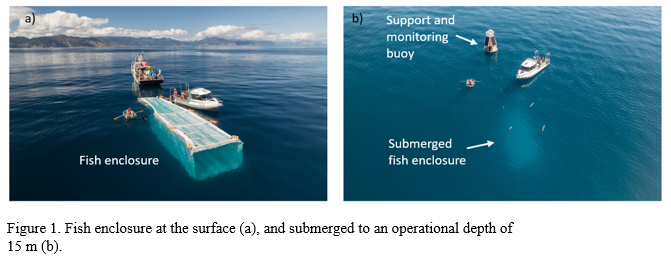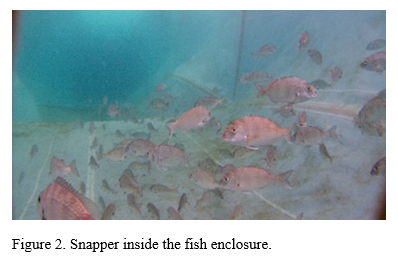RE-IMAGINING OPEN OCEAN AQUACULTURE: DESIGNING WITH THE FISH IN MIND
Introduction
Global seafood demand is anticipated to increase over the long term, with finfish mariculture poised to become a major contributor to future supply [1]. As sheltered, nearshore marine environments are highly valued and regulated and are already occupied in many areas of the world, open ocean aquaculture (OOA) is the most likely way to meet global demand for finfish.
A typical approach to design OOA fish enclosures is to enlarge and fortify existing technologies with the aim to both increase production biomass and to withstand extreme oceanographic forces [2,3]. The New Zealand-based Whakapōhewa ki ahumoana Reimagining Aquaculture project (funded by the Ministry for Business, Innovation and Employment Endeavour Fund) lead by Plant & Food Research, has taken a different approach. Focussing firmly on the needs of the fish, they have designed a system to support healthy fish growth, limit adverse impacts on the marine environment and withstand the physical impacts of sometimes harsh and unpredictable offshore conditions [4].
This presentation describes the very first biological trials of this soft-engineered, semi-mobile aquaculture production system with two exemplar species: Australasian snapper/tāmure/silver sea bream (Chrysophrys auratus) and Chinook/King salmon/hāmana (Oncorhynchus tshawytscha).
The innovation: a semi-mobile aquaculture production system
A 500m3 soft-engineered fish enclosure (20m x 5m x 5m) was constructed utilising a laminated ultra-high molecular weight polyurethane fabric with nets placed at the front and back of the enclosure (Figure 1).
The fish enclosure is tethered to a mooring setup allowing the system to swing about the mooring as the tide changed. A support and monitoring buoy (Figure 1b and 2) delivers feed as well as providing a conduit for sensors and underwater camera cabling for monitoring fish inside the enclosure via a flexible umbilical tube to a depth of 15 m.
In early April 2025, approx. 2000 snapper were transported to the trial site and introduced to the system (Figure 2) where they resided in the system for 6 weeks, with approx. 3000 salmon transferred in July. Both species were fed an appropriate commercial pellet diet. Remote monitoring of fish was possible through a continual live underwater video feed.
Results
Fish were successfully cultured in the semi-mobile system, gaining weight and maintaining health and condition during the trials. The system and fish were subject to a number of substantial weather events during the trial period. Being submerged to a depth of 15 m meant that significant wave motion was avoided compared with surface waters. Feed, monitoring and remote communications were maintained throughout the trial.
Discussion
To our knowledge, this is the first large-scale demonstration of finfish successfully reared in a submerged, soft-engineered, and semi-mobile aquaculture system. The integration of underwater feeding and continuous video monitoring enabled deployment at a high-energy offshore site and facilitated trials across two biologically distinct species. Engineered around fish welfare, the system can be fully mobile—capable of being towed to track favourable thermal and water quality conditions. This novel, fish-centred approach represents a step-change in offshore aquaculture, offering a low-impact, scalable solution with the potential to reduce capital and operational costs while unlocking under-utilised open ocean areas for sustainable finfish production.
References
[1] FAO. 2024. The State of World Fisheries and Aquaculture 2024 – Blue Transformation in action. Rome, Italy.
[2] Thorvaldsen T, Salomonsen C, Ranum S.A, Trædal P. Misund A, Holmen I.M. 2023. Prepared for the Worst? Emergency Preparedness in Norwegian Fish Farming – Status and Further Improvements. Aquaculture 577, p. 739921.
[3] Bjelland HV, Fore M, Lader P, Kristiansen D, Holmen IM, Fredheim A, Grotli EI, Fathi DE, Oppedal F, Utne IB, and Schjolberg I. 2015 Exposed Aquaculture in Norway. OCEANS 2015 - MTS/IEEE Washington, IEEE, Washington, DC, pp. 1–10.
[4] Black S, Vennell R, Kregting L, Moran D, Cook D, Janssen G. 2024. Designing for the animal: reimagining offshore fish structures. Proceedings of the ASME 2024 43rd International Conference on Ocean, Offshore and Arctic Engineering OMAE2024 June 9-14, 2024, Singapore EXPO, Singapore.

